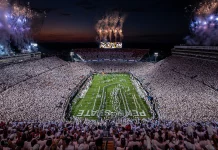
As that sage philosopher Yogi Berra supposedly opined, “It’s tough to make predictions, especially about the future.”

Not to worry.
We’re diving right in with a bold forecast of where college football is headed over the next decade, with the caveat that we’ve got about as much chance of getting this right as landing a ticket to a Taylor Swift concert. Here goes:
2023 — After breaking all box office records, “Barbie” gets invitations from both the Southeastern Conference and Big Ten. She politely declines, deciding it’s more profitable for now to remain on a twin bill with “Oppenheimer.” Nevertheless, Mattel begins exploring whether to add a pink stadium to its line of Barbie products.
2024 — In previously announced moves, Texas and Oklahoma move to the SEC, Southern Cal and UCLA join the Big Ten, and Colorado returns to the Big 12. The Big Ten also adds Washington and Oregon, the Big 12 picks off Arizona, Arizona State and Utah, and the Pac-12 changes its name to the Pac-4. The “Conference of Champions” finally lands a TV deal, agreeing to a 12-year, $17.50 package with ESPN8, The Ocho.
2025 — In a stunning move, Elon Musk pays $44 billion for the Pac-4, rebrands it Conference X, shoos away its last four members and hires Joe Rogan as commissioner. With membership down to zero, the league insists that it remains a viable entity but still gets dropped from the College Football Playoff (which no one realized it was eligible for, anyway).
2026 — The World Cup comes to the United States, so naturally the SEC seizes the moment by grabbing France, Germany and Italy for its new European Division before their squads can return home. Not to be outdone, the Big Ten expands further westward with clubs from Japan, South Korea and Australia.
2027 — After realizing that France, Germany, Italy play a different kind of football, an embarrassed SEC disbands its European Division. But the Big Ten doubles down, growing to 106 teams playing several variations of football on every continent, including the newly founded University of Antarctica (which, with rapidly warming temperatures, has become a trendy destination for high school grads). The league announces a new $1.7 quadrillion television package that will allow it to show a weekly block of games from 6 a.m. Saturday until midnight Friday.
2028 — Perturbed at the Big Ten for expanding into its South Pole footprint, the SEC swipes Clemson, Florida State, Miami from the Atlantic Coast Conference. The remaining ACC members drop their football programs, finally acknowledging they really are a basketball league.
2029 — Notre Dame ends its decades-long tease by deciding to join a football conference. Still mad at being blackballed from the Big Ten by former Michigan coach Fielding Yost (who died in 1946) and realistic that they have no chance of beating anyone in the SEC beyond Vanderbilt, the Fighting Irish announce they are headed to the Big 12.
2030 — Suddenly realizing that the Big 12 still exists, and had actually grown to 32 members with the addition of Notre Dame, the Big Ten and SEC swoop in to divvy up a bunch of schools that neither conference really wants. Asked why they executed this disgraceful power play against a league with more survival skills than Bear Grylls (who, coincidentally, had been named head of the Big 12 a few years earlier), commissioners Greg Sankey and Tony Petitti issue a simple joint statement: “Spite.”
2031 — Angry at the demise of the Big 12, not to mention its 70-7 loss to Baylor in the conference’s final championship game, Notre Dame returns to being an independent. But the Fighting Irish promise to explore the possibility of joining either the Big Ten or SEC in the near future. We’ll check back around 2050.
2032 — The major college landscape now consists of only two super, duper conferences. The College Football Playoff expands to 48 teams, split evenly between the SEC and Big Ten. Even with all those schools, the title game is all too familiar: Georgia vs. Alabama. The Crimson Tide wins its fifth in the last decade (the Bulldogs had claimed the other five) and rewards 81-year-old Nick Saban with a 25-year, $500 million contract extension. Saban, who has purchased most of neighboring north Georgia to build second, third and fourth vacation homes, grumbles about the ruinous effects of NIL on the college game.
2033 — With fan interest waning and griping that a 24-game conference schedule is too taxing on the players — remember, it’s all about the student-athletes — the Big Ten and SEC decide to split their memberships along regional lines. The Big Ten spins off its western schools into a new entity known as the Pac-10. The SEC assigns its members along the Atlantic seaboard to an upstart league known as the ACC. A joint venture takes a dozen schools in the middle of the country; the Big 12 is deemed an appropriate moniker.
Suddenly, everyone realizes it is 1996 all over again.
___
Paul Newberry is the national sports columnist for The Associated Press. Write to him at pnewberry@ap.org
___
AP college football: https://apnews.com/hub/college-football and https://twitter.com/ap_top25. Sign up for the AP’s college football newsletter: https://tinyurl.com/mrxhe6f2






